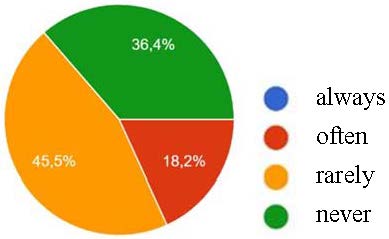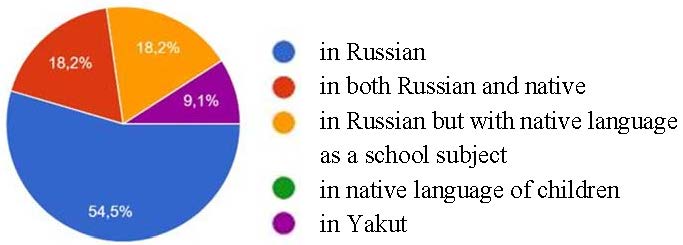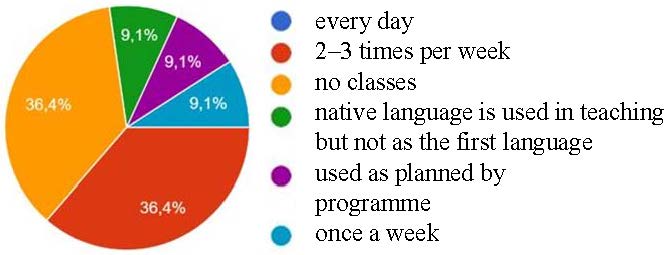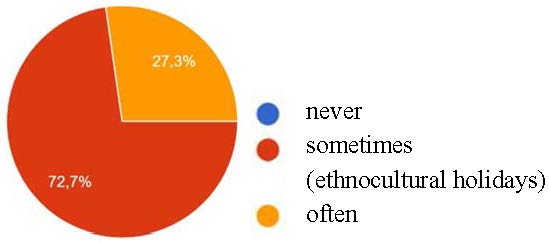Abstract
The paper addresses the main issues on how to transfer to children the language heritage of the indigenous small peoples of the North, Siberia and the Far East in the conditions of kindergarten (pre-school). Many of the leading linguistic scholars believe that indigenous languages are on the verge of extinction because these languages have appeared outside pre-school and school education, and their operational scope is at best limited to family and domestic communication. The study relevance is related to the fact that pre-school educational institutions involved in revitalization of the ethnic languages of the indigenous small peoples of the North, Siberia and the Far East, require a special bilingual educational system, developed on the basis of the federal state educational standards prescribed for pre-school education, with an effective methodology able to create an appropriate language environment. In order to develop a special bilingual educational system based on the federal state educational standards for pre-school education and the language environment approach, first of all, it is necessary to identify the main challenges of transferring to children the linguistic heritage of the indigenous small peoples of the North, Siberia and the Far East in the conditions of kindergarten. The paper analyzed the results of the online questionnaire conducted among the heads of pre-school educational institutions located in the places of the residence where the indigenous small peoples of the North, Siberia and the Far East of the Russian Federation live.
Keywords: Language Nest method, languages revitalization, developing language environment, ethnic languages
Introduction
Worldwide, at least 40 % of the 7,000 world languages are under with extinction. In this regard, the United Nations has declared the International Decade of Indigenous Languages for the period from 2022 to 2032 recognizing the special role of languages in social consolidation, realization of the cultural rights of indigenous peoples, given their importance in sustainable development and biodiversity conservation. The Los Pinos Declaration, adopted on 28 February 2020, outlines the strategic recommendations for the Decade, including the right of indigenous peoples to receive education in their native language and the need to expand its functions in social life (ru.unesco.org, 2020).
The Russian Federation, which is the ‘home’ to 45 officially recognized indigenous small peoples, is an active participant in the international process for the preservation of endangered ethnic languages, is ready to take some effective measures aimed at improving the language situation among the traditional indigenous small peoples.
Many of the leading linguistic scholars believe that indigenous languages are on the verge of extinction because these languages have appeared outside pre-school and school education and their operational scope is at best limited to family and domestic communication (Edwards, 1992). Some foreign and domestic leading linguistic scholars, engaged in researching native languages of indigenous small peoples, including specialists of the Institute of Linguistics of the Russian Academy of Sciences, consider for the revitalization of endangered languages the most effective method to be the “Language Nest” method. The method implies the ethnic language transfer from the older generation to children, who are at their kindergarten age, in the conditions of full language immersion due to the environment created deliberately. The method was successfully implemented in New Zealand in the revival of the Maori language through its transmission to children who speak the majority language, then, it was used in Hawaii to expand the functions of the Hawaiian language, then in the Sami region of Finland in the attempt to rescue the Inari-Sami and Koltta Sami languages (Zuckermann & Walsh, 2014).
In the pre-school education system of Russia, this method, successfully applied abroad to rescue some ethnic languages of indigenous peoples, is being introduced through the implementation of the Finnish-Ugore projects “Kielipesa” (Language Nest) and “Finno-Ughor languages and cultures in pre-school education” (Dolzhenko & Bayanova, 2016). In the historic Karelian village Kalevala, the project was implemented from 2000 to 2006 in two kindergartens and helped to raise the status of the Karelian language in the region. In the experimental groups the number of children did not exceed 15. The communication was run by the teachers only in Karelian language. About a hundred Kalevala families were involved in this project, but the project was suspended in 2006. The leaders of Karelia’s education system have come to the conclusion that further implementation of the project “full immersion in the language environment” on the basis of state kindergartens is impossible. Then, they made the adjustment to the strategy guiding the project implementation (“Language Nest”), which allowed its implementation “by partial immersion in the language environment”, in the city Petrozavodsk, the capital of the Republic of Karelia. In one group, two teachers communicated with children in different languages – in the Olonets dialect of Karelian and in Russian, in a neighboring group the communication was carried out in Finnish and Russian languages (Pasanen, 2011).
In the Taimyr Dolgano-Nenets municipal district of Krasnoyarsk region, the method of “partial immersion in the language environment” is introduced in the conditions of educational institutions of the villages Ust-Awam, Volchanka, Potapova. There the teachers, working under the federal state educational standards of pre-school education, make the most of all the opportunities of basic and additional education for transmission language and cultural heritage to children. In informal education, the “Language Nest” method is also partially implemented once a week in the Taimyr House of Folk Art when studying the languages and cultures of the Enetsky, Dolgan, Nganasan, Evenki, Nenets peoples. In contrast to classroom, optional learning in “Language Nests” classes the transmission of ethnic language is carried out through direct communication between children and adults in active learning traditional culture through the ethnopedagogy methods (Golovko et al., 2018).
Problem Statement
Our study on bilingual education was conducted on the State assignment of the Ministry of Education of the Russian Federation on the topic “Research on didactic techniques aimed at creating developing language environment and on examining the present-day situation showing how the native languages function in educational institutions located in the places of residence of indigenous small peoples of the North, Siberia and the Far East of the Russian Federation”. To do this research, the method of “Language Nest” is very promising as it is created based on two main factors helping pre-school children master the native language: 1) using the possibilities of the basic sensitive period for speech development among children under 6 years, the period is considered as the most effective to learn languages (Garnica & King, 1979); 2) the unique potential of the language environment called as ‘input’, taken as adults’ speech outcomes addressing a child, which has the significant value in spontaneous mastering a language (Zeitlin, 2017).
The content analysis targeted at the practice of the “Language Nest” method implementation in transmission of some ethnic languages in the context of their limited functioning and/or partial loss shows that it is based, first of all, on a functional approach, effectively implemented on the model of “one language – one person”, distributed mainly in the context of family education for the parallel bilingualism development among pre-school children on the basis of the language (Androsova, 2019).
It is also obvious that pre-school educational institutions, who use the “Language Nest” method without the appropriate organizational and educational conditions declared by the federal state educational standards of pre-school education and scientific and methodical support (described in national scientific works on language pedagogy), have some difficulties.
The study relevance at this stage is related to the fact that pre-school educational institutions involved in revitalization of the ethnic languages of the indigenous small peoples of the North, Siberia and the Far East, require a special bilingual educational system, developed on the basis of the federal state educational standards of pre-school education, with an effective methodology able to create a proper language environment. In our study, we use the term “developing language environment” introduced by Fedorenko (1999), a major scientist in the field of teaching Russian, in the 70s and 80s of the 20th century and actively used in the theory and practice of pre-school education of the Russian Federation.
Research Questions
We have the following key research questions, without which it is impossible to create an effective method aimed at developing and enriching children’s speech in their native language:
1. What is the level of the native language proficiency among teachers, children and their parents? Who are potential participants in restoring endangered languages in kindergarten?
2. What are the conditions for the native languages studying in pre-school educational institutions in the places of traditional residence of the indigenous small peoples?
3. Is there a developing capacity of the language environment in the places where the indigenous small peoples live?
Purpose of the Study
In order to develop a special bilingual educational system based on the federal state educational standards of pre-school education and the language environment approach, first of all, it is necessary to identify the main challenges of transferring to children the linguistic heritage of the indigenous small peoples of the North, Siberia and the Far East in the conditions of kindergarten.
Research Methods
The main method of the study was the online questionnaire, which allows to remotely covering the necessary number of respondents regardless of their location due to the special software offered by Google (GoogleForms). Some individual questionnaires were conducted among the heads of pre-school educational institutions of 12 settlements (villages and towns) of 6 subjects of the Russian Federation: Amur region, Khabarovsk region, Kamchatka region, Buryatia Republic, Sakha Republic (Yakutia), Yamalo-Nenets Autonomous Region, where the native languages for these regions are Evenki, Ulch, Even, Nenets, Selkaku. When selecting the educational institutions, we took into account some quantitative and qualitative criteria, such as the number of the indigenous small peoples, including their native languages, the presence of separate kindergartens (legal entities), the strategy of the regional language policy, the level of development of ethnocultural education in the region (federal subject) of Russia.
The online questionnaire consisted of 25 open and closed questions, which were compiled taking into account the key research questions and 3 main components of the developing language environment highlighted by Fedorenko (1999) (quality of teachers’ speech, special conditions for speech development to master a native language, teaching methods used to develop/improve children's speech activities).
Findings
In each pre-school educational institution, about 50–80 per cent of the pupils are the representatives of the small indigenous peoples. In 10 kindergartens, only 1–2 teachers speak the native language of the children and 17 teachers speak the children's native language fluently in two institutions.
In six pre-school educational institutions there was noted that no child speaks the ethnic language. In two institutions there are only 2–4 children who speak the native language and only one institution reported that all 129 children speak their native language.
When asked “Do children speak their native language in everyday life” 45.5 % of the respondents answered that it happens rarely and 36.4 % said ‘never’ (Fig. 01).

The main educational program in the majority (54.5 %) kindergartens is implemented in the Russian language; the rest is carried out in Russian with the native language studied in parallel in classroom (Fig. 02).

Almost all kindergartens that were under survey (72.7 %) do not use the “Language Nest” technique.
36.4 % of the respondents have classes in their native language 2-3 times a week, while the rest do not have such classes at all (Fig. 03).

Among the most popular events, aimed at saving the native language and culture, are national holidays, competitions and contests, some family projects.
Almost all kindergartens have created a substantive and educational environment for children to develop their native language speech (thematic corners, information stands for parents, didactic demo materials).
Hobby-classes aimed at learning the native language are not in practice now. Half the institutions have organized the additional classes on practical and applied crafting.
Most of the pre-school educational institutions that took part in the study do not provide for specially organized teaching which aims to increase the native language proficiency among the teaching staff. Many leaders (63.6 %) noted that each teacher should independently improve the level of the proficiency in their native language.
There are no events among parents stimulating them to discuss issues relating to learning their native language and culture. In most kindergartens this direction is carried out only through publishing/placing useful information on the stands.
In 72 % of kindergartens, their native language is sometimes used when some ethnocultural holidays are held (Fig. 04).

Conclusion
Based on the research data, it can be concluded that in pre-school educational institutions the potential of developing language environment for the native languages of the indigenous peoples is only partially used. Of the three main components of the developing language environment, only special visual and informational material is most actively used (thematic corners, information stands for parents, didactic demo materials). The other two components – teaching methodology and teacher’s speech – are at a very low level. In most of the kindergartens participated in the study, due attention is not paid to the development of teaching staff speech in the native language; there is no general system to organize the educational process in the native languages.
In this regard, in order to eliminate language deprivation, which has become a stable phenomenon in pre-school educational institutions, in which children of the indigenous small-numbered peoples of the North, Siberia and the Far East of the Russian Federation are brought up, it is necessary to take some systemic measures aimed at improving the quality of teachers’ speech, creating the didactic materials, including the digital resources, to create the developing language environment, and the development of some special techniques that reveal the speech potential of children.
1) We propose to introduce into the system of bilingual pre-school and secondary education the concept “language of the teacher’s professional activity”, which can consist of two components: the language of formal pedagogical communication and the language of informal pedagogical communication. The formal pedagogical communication is educational and business communication applied to do the educational activities. An educator, who has the competence to conduct the educational process (teaching) in the native language of pupils, will make a significant contribution to the revitalization of languages. The informal pedagogical communication is the interpersonal communication in regime moments that uses the vocabulary of everyday communication. This type of communication performs an educational function. It is desirable to have the kindergarten staff speaking the language of informal (everyday) communication in the native languages of endangered indigenous peoples in order to support the speech development among pupils.
2) In the job requirements as the official duties for kindergarten staff, who work in places, where the indigenous peoples of the North, Siberia and the Far East live, it is necessary to prescribe the knowledge of the native (ethnic) languages of pupils used for the basic and additional educational programs. We note that the regulatory and legal framework of the Russian Federation, which is applied in the field of education, for example, the professional educational standards and the Labor Code allow an employer to express what he/she wants, taking into account the specifics of the educational process.
3) Conducting advanced training courses “Language of professional activity (informal communication)” for all employees of pre-school educational institutions, when lecturers are going out to the places of the residence where the indigenous peoples of the North, Siberia and the Far East live, is one of the most effective forms of the speech competence development among pedagogical and technical personnel.
4) When training teachers, we consider one of the best options allowing teaching the native languages of the indigenous minorities of the North, Siberia and the Far East of the Russian Federation to future applicants who have chosen the profession of a teacher, according to the model of teaching Russian to foreign students. After completing the courses, young people can enroll in various pedagogical specialties, for example, at the Russian State Pedagogical University named after A.I. Herzen and North-Eastern Federal University named after M.K. Ammosov. With good speech skills and abilities, students can maintain and further develop them through additional education and speaking club activities. Then, kindergartens and schools will be attended by educators, teachers of physical education, music, social sciences, additional education, who speak the native languages of the indigenous peoples of the North, Siberia and the Far East of the Russian Federation.
3) WorldSkills project implementation for young teachers, who deal with the professional language competencies, necessary to work in conditions of bilingualism and multilingualism according to the model (Russian is the native language of students (pupils)).
4) Special methodology which aims to create the developing language environment for revitalization of the endangered languages of the indigenous peoples, it is necessary to further develop the theory and technology of the environmental approach that has been proposed by V.A. Yasvin, Doctor of Psychological Sciences, Yu.S. Manuilov, Doctor of Pedagogical Sciences, S.V. Ivanova, Doctor of Pedagogical Sciences, and many other Russian and foreign scientists. In language pedagogy, it is necessary to expand the theory of the developing the potential of the language environment, taking into account the patterns of speech development, mastering the native speech in conditions of bilingualism. The developing potential of the language environment is the capacity of the language environment (natural or artificial) in which a child grows up. In a kindergarten or school, an artificial language environment is created to solve the language education challenges, mainly in the framework of learning a foreign language. Fedorenko (1999) spoke about the need to create such a language environment specifically for the development of the native speech in view of its special importance for emotionally healthy and intelligent person development.
5) To create a special bilingual educational system, developed on the basis of the federal state educational standards for pre-school education and aimed at revitalization of the endangered languages of the indigenous peoples of Russia, it is necessary to conduct the research in the field of the quality and effectiveness of language education to children in kindergartens, who use the potential of developing language environments, including the “Language Nest” method.
Acknowledgments
The author of the paper expresses the gratitude:
1. To the Ministry of Education of the Russian Federation for providing a state assignment for conducting applied research on the topic “Development of the didactic system and methodology able to create the developing language environment in the native language in educational institutions located in places of residence of the indigenous peoples of the North, Siberia and the Far East of the Russian Federation” on 2020-2022 (unique number of the register entry of the project is 730000F.99.1.BV10AA00006).
2. To the scientific supervisor of the project Elizaveta Khamraeva, Doctor of pedagogical sciences, professor, for conducting seminars, to the staff of “Linguodidactics and innovative methods of teaching languages” laboratory located at the Institute of National Schools of the Republic of Sakha (Yakutia) for assistance in carrying out the research and participation in the discussion organized specially to make up a draft for this paper.
3. To the heads of pre-school educational institutions of the Amur Region, Khabarovsk and Kamchatka Territories, the Republics of Buryatia and Sakha (Yakutia), the Yamalo-Nenets Autonomous District, who took an active part in the study of the language environment in the native languages of the indigenous peoples of the North, Siberia and the Far East of the Russian Federation.
References
Androsova, Y. V. (2019). Model of development of national-Russian bilingualism in children through gaming. World of Sci. Pedag. and Psychol., 7(6).
Dolzhenko, S. G., & Bayanova, E. V. (2016). “Language Nest” as a way to solve the problem of the disappearance of the languages of the indigenous small peoples of the North. Philol. Sci. Quest. of theory and pract., 6-2, 191–193.
Edwards, J. (1992). Sociopolitical aspects of language maintenance and loss: towards a typology of minority language situations. In W. Fase, K. Jaspaert, & S. Kroon (Eds.), Maintenance and loss of minority languages (pp. 37–54). John Benjamins.
Fedorenko, L. P. (1999). The development of pre-school children speech. Prosvyashenie.
Garnica, O. K., & King, M. I. (1979). Language, Children and Society: The Effect of Social Factors on Children Learning to Communicate.
Golovko, E. V., Sokolovsky, S. V., Shluinsky, A. B. (2018). Language policy in the context of “Strategy of the state nationality policy of the Russian Federation for the period up to 2025”. In Language policy in modern Russia: problems and prospects (pp. 4–53). Russ. State Univer. for the Human.
Pasanen, A. (2011). “Language nest” in the process of revival of the Finno-Ugric languages: experience and prospects. The Finno-Ugric world, 2–3, 20–25.
Zeitlin, S. N. (2017). Language and child. Native language mastered by a child. Vlados.
Zuckermann, G., & Walsh, M. (2014). Ancestors Are Happy!: Revivalistics in the Service of Indigenous Wellbeing. Foundation for Endangered Languages, XVIII, 113–119.
Copyright information

This work is licensed under a Creative Commons Attribution-NonCommercial-NoDerivatives 4.0 International License.
About this article
Publication Date
17 May 2021
Article Doi
eBook ISBN
978-1-80296-106-5
Publisher
European Publisher
Volume
107
Print ISBN (optional)
-
Edition Number
1st Edition
Pages
1-2896
Subjects
Science, philosophy, academic community, scientific progress, education, methodology of science, academic communication
Cite this article as:
Androsova, Y. (2021). Language Environment In Pre-School Educational Institution For Mastering Native Language By Child. In D. K. Bataev, S. A. Gapurov, A. D. Osmaev, V. K. Akaev, L. M. Idigova, M. R. Ovhadov, A. R. Salgiriev, & M. M. Betilmerzaeva (Eds.), Knowledge, Man and Civilization - ISCKMC 2020, vol 107. European Proceedings of Social and Behavioural Sciences (pp. 1856-1864). European Publisher. https://doi.org/10.15405/epsbs.2021.05.246

